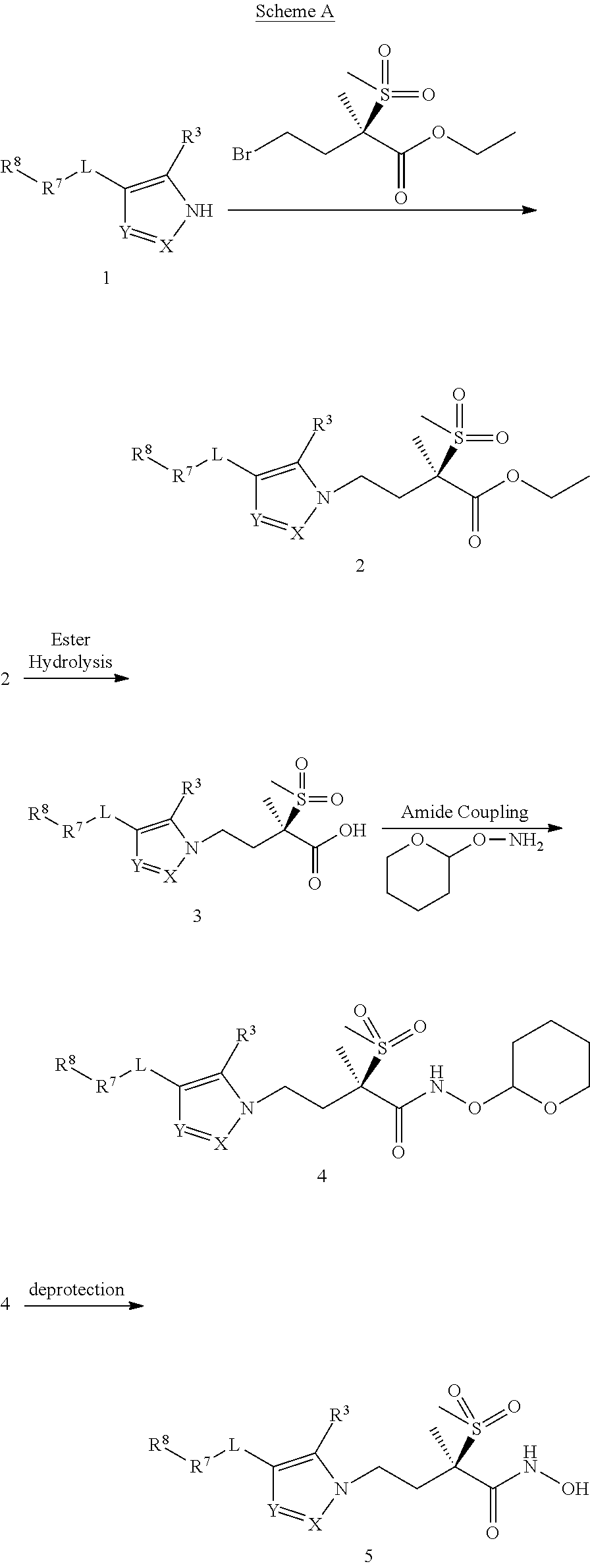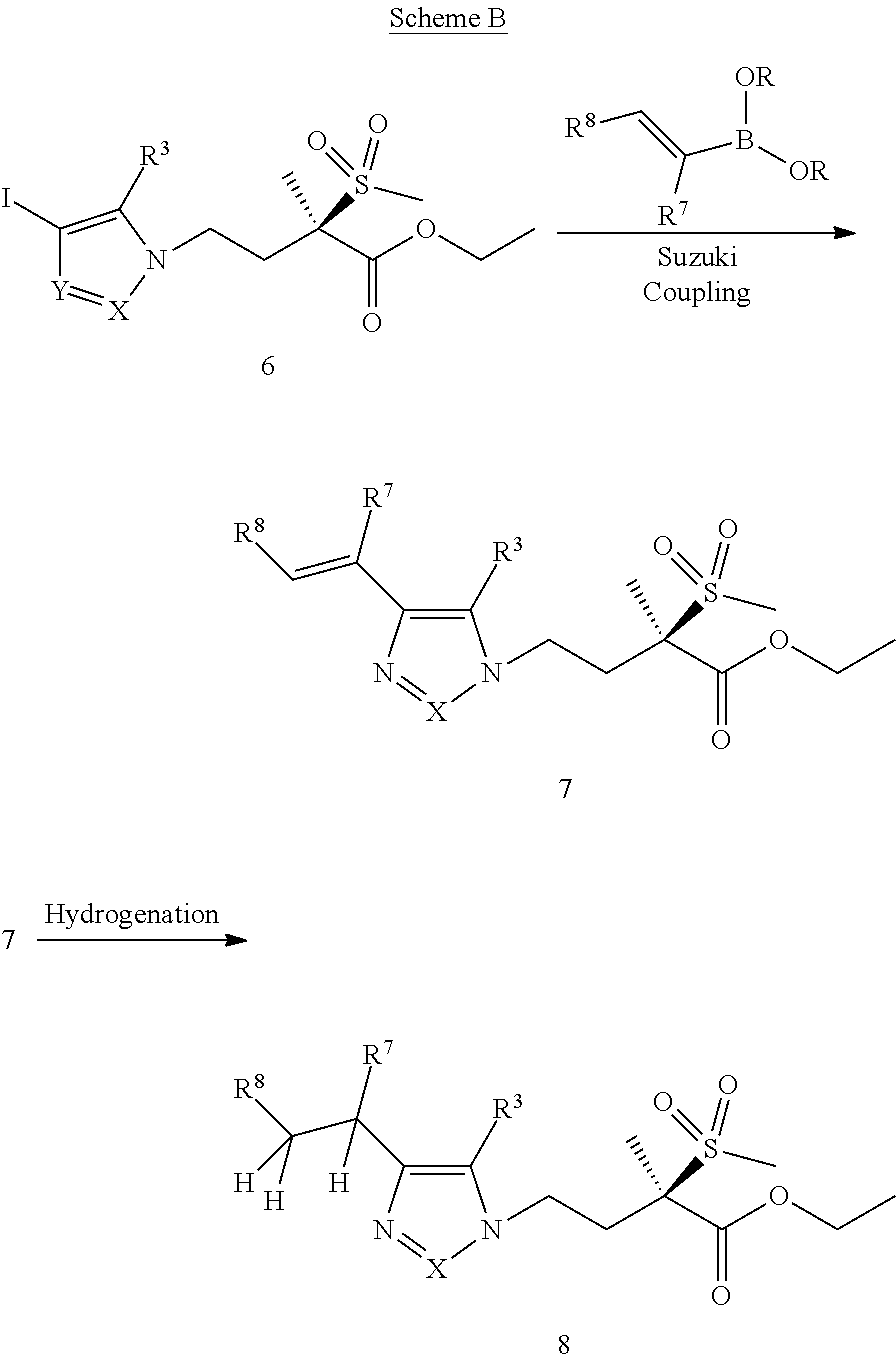Imidazole, Pyrazole, and Triazole Derivatives Useful As Antibacterial Agents
- Summary
- Abstract
- Description
- Claims
- Application Information
AI Technical Summary
Benefits of technology
Problems solved by technology
Method used
Image
Examples
preparation 1
Ethyl 2-(methylsulfonyl)propanoate
[0209]
[0210]Sodium methyl sulfinate (103 g, 937 mmol) was combined with the ethyl 2-chloropropionate (109 g, 892 mmol) in EtOH (350 mL) in a 500 mL one neck round bottom flask. The reaction was warmed to 77° C. for 20 hours, and then allowed to cool to room temperature. Solids were removed by filtration through celite, and the filter pad was washed with EtOH. The combined filtrates were concentrated in vacuo. The crude product was suspended in diethyl ether (250 mL), and solids were removed by filtration. The filtrate was concentrated in vacuo to afford the title compound as a pale yellow oil (51 g, 73%). 1H NMR (400 MHz, CHLOROFORM-d) δ 1.32 (t, J=7.05 Hz, 3H) 1.67 (d, J=7.47 Hz, 3H) 3.05 (s, 3H) 3.83-3.92 (m, 1H) 4.18-4.37 (m, 2H).
preparation 2
(+ / −)-Ethyl 4-bromo-2-methyl-2-(methylsulfonyl)butanoate
[0211]
[0212]Sodium hydride (60% dispersion in mineral oil, 2.33 g, 58.3 mmol) was washed with hexane (2×10 mL) in a 100 mL two neck round bottom flask under nitrogen and then suspended in DMF (30 mL). The suspension was treated dropwise with ethyl 2-(methylsulfonyl)propanoate (10.0 g, 55.49 mmol) in DMF (10 mL). The mixture was stirred for 30 min at RT, cooled to 0° C., and treated dropwise with 1,2-dibromoethane (5.17 mL, 58.8 mmol). The mixture was allowed to warm to room temperature while stirring overnight. The mixture was quenched with saturated ammonium chloride (100 mL) and then extracted with diethyl ether (4×50 mL). The combined organic layers were washed with 50% saturated sodium chloride (4×50 mL), dried (MgSO4), filtered and the filtrate concentrated in vacuo. The crude material was chromatographed over silica gel (350 g, 230-400 mesh) eluting with 10-20% EtOAc / hexane to afford the title compound as a pale yellow oi...
preparation 3
Ethyl (2R)-4-bromo-2-methyl-2-(methylsulfonyl)butanoate
[0213]
Chiral separation of (+ / −)-Ethyl 4-bromo-2-methyl-2-(methylsulfonyl)butanoate
[0214]Crude (+ / −)-ethyl 4-bromo-2-methyl-2-(methylsulfonyl)butanoate (1.82 kg) was purified via flash chromatography using an LP-600 column and toluene as the eluant to afford pure (+ / −)-ethyl 4-bromo-2-methyl-2-(methylsulfonyl)butanoate (1.63 kg). The purified material was dissolved in EtOH (75 g / L) and resolved via chiral multi-column chromatography (condition listed in Table 1) on MCC-2 to afford enantiomer #1 (738.4 g, =4.719 min, [α]58920=+14.1°) at 99% enantiomeric purity and enantiomer #2 (763.8 g, =4.040 min) at 95% enantiomeric purity. Purity of the enantiomers was determined via chiral HPLC, 4.6×250 mm Chiralpak AD, 10μ column, 215 nm wavelength, mobile phase: EtOH, isocratic elution at 1 mL / min at ambient temperature. Enantiomer #1 was determined to be Ethyl (2R)-4-bromo-2-methyl-2-(methylsulfonyl)butanoate.
TABLE 1Stationary PhaseChiral...
PUM
 Login to View More
Login to View More Abstract
Description
Claims
Application Information
 Login to View More
Login to View More - Generate Ideas
- Intellectual Property
- Life Sciences
- Materials
- Tech Scout
- Unparalleled Data Quality
- Higher Quality Content
- 60% Fewer Hallucinations
Browse by: Latest US Patents, China's latest patents, Technical Efficacy Thesaurus, Application Domain, Technology Topic, Popular Technical Reports.
© 2025 PatSnap. All rights reserved.Legal|Privacy policy|Modern Slavery Act Transparency Statement|Sitemap|About US| Contact US: help@patsnap.com



